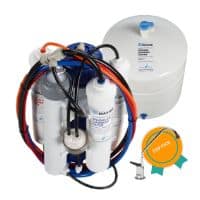Did you know that Singapore has the cleanest tap water in the world?
The government uses reverse osmosis(RO) as part of the process to translate everyday wastewater into pure water due to the lack of water sources.
The core filtration element is the semipermeable RO membrane which is a 0.00001-micron rating that is capable of removing 99% of contaminants.
While many claims that RO water is not safe to consume due to its slightly acidic, Water Quality Association(WQA) claims otherwise.
Best RO System Review
- Home Master TMAFC – Best Reverse Osmosis System
- Waterdrop G3 – Best Tankless Reverse Osmosis System
- iSpring RCC7 – Best Home Reverse Osmosis System
- Home Master TMHP – Best Reverse Osmosis System for Well Water
- APEC RO-PH90 – Best Under Sink Reverse Osmosis System
- AquaTru – Modern Countertop RO System
Home Master TMAFC – Best Reverse Osmosis System

Features:
| Our Rating | 4.8 / 5 |
| Price | $$$ |
| Flow Rate | 1 Gallon per Minute |
| Filter Process | 7 Stages of Filtration (Artesian filter, coconut shell carbon, and the Patented Full Contact(R) Remineralization system) |
| Annual Cost | $60 – $69 |
| Warranty | 5-year Limited Warranty |
| Life Span | 1 year for the RO filter, 3 – 5 years for the RO Membrane |
| Certification | NSF Certified Components |
| Waste WaterRatio | 1:1 |
With their TMAFC model, Home Master has offered one of the best patented reverse osmosis systems. Their innovative design eliminates all common problems associated with the canister and tankless systems.
It offers a patented double remineralization system that is mainly there to provide you with water quality that is healthy and great tasting in addition to beneficial minerals. This system works to add calcium and magnesium to the water twice during the filtration process. This also prevents acidic water from entering the storage tank and faucet.
It has an advanced modular filter that removed the need for filtration housing. It is hygienic and prevents cracks or leaks in the water filter.
This water filtration system offers 2 times faster flow rates as compared to most RO systems, with its larger fittings and tubings. It also reduces water waste to a great extent with the help of its non-electric permeate pump.
This is a great choice for customers who are ready to make a big investment in healthy bottled water since this RO filter system is a little costly.

Pros
- Great water quality that tastes great as well
- High flow rates are offered as promised
- The company offers good customer support
Cons
- The installation process is not beginners friendly, and the instructions are vague
- Some customers complain that the water waste ratio is higher than 1:1
Maintenance: All of the filters have a lifespan of at least one year while the RO membrane can last for 3 years before a replacement is needed.
To learn more, visit the Home Master TMAFC review.
Waterdrop G3 – Best Tankless Reverse Osmosis System
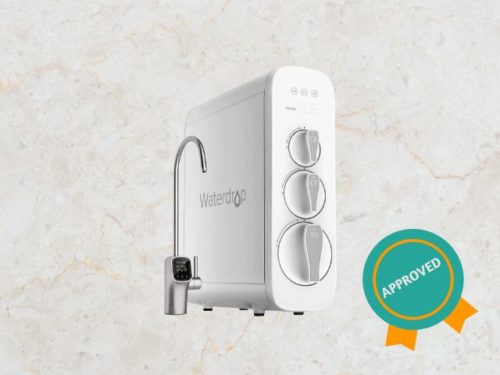
Features:
| Our Rating | 4.8 / 5 |
| Price | $$$$$ |
| Flow Rate | 0.28 Gallons per Minute |
| Filter Process | 7 stages of Filtration (granular activated carbon filter, reverse osmosis filter, and carbon block filter) |
| Annual Cost | $57 – $90 |
| Warranty | Limited 30 days warranty |
| Life Span | 6 months for the filter, 1 year for the RO membrane |
| Certification | NSF 58 and 372 |
| Waste WaterRatio | 1:1 |
If space is a concern under your sink, you definitely wanted to check out the Waterdrop G3 Tankless RO System.
This tankless system can also be connected to your refrigerator if it comes to that.
One of our favourite founds on Waterdrop G3 is that it has a smart system that automatically flushes its filters when the device has consistently worked for two consecutive hours, or when G3 is left to be unused for 24 hours.
Another reverse osmosis systems feature that makes it stand out among its competitors is that to preserve the functionality and parts of G3, it has an auto shut-off mode when it has consecutively dispensed tap water for 30 minutes. This is not a great feature for you if you need a filtration system that works longer than that.
If your water supply is from a nearby well, this reverse osmosis system might not be your best option because it doesn’t quite work on the complicated composition of well water. You also need to be prepared for an altered tap water taste as this is a salt-based softener.
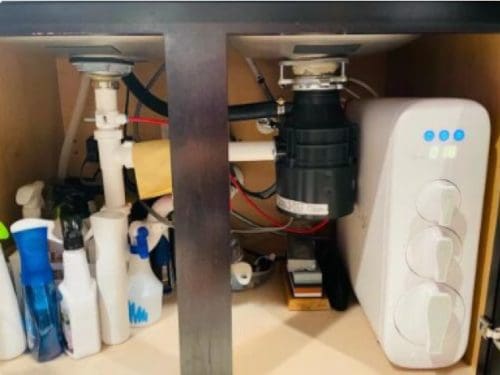
Pros
- Some people complain that the faucet is flimsy and starts leaking very early on
- Very easy and quick to install and comes with a comprehensive instruction booklet
- With the correct additional equipment bought, this reverse osmosis system can also be connected to your refrigerator
Cons
- Remineralization of healthy minerals is not offered
- TDS does not drop below 10%, and the reading showed is also mostly incorrect
To learn more, please visit our Waterdrop G3 reverse osmosis system review.
iSpring RCC7 – Best Home Reverse Osmosis System
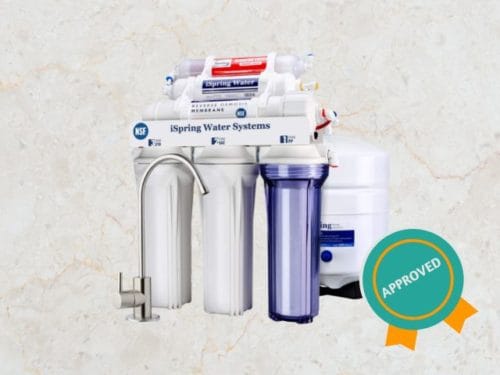
Features:
| Our Rating | 4.6 |
| Price | $ |
| Flow Rate | 0.5 Gallons per Minute |
| Filter Process | 5 stages of Filtration (pre-sediment filter, 2 activated carbon pre-filters, a reverse osmosis membrane filter, and a post-carbon filter) |
| Annual Cost | $50 – $85 |
| Warranty | 1 year manufacturer warranty |
| Life Span | 6 months for the pre-filter, 3 years for the reverse osmosis membrane, and one year for the post-filter |
| Certification | NSF/ANSI standard 58 by WQA (gold seal award) |
| Waste WaterRatio | 1:1.5 |
The iSpring RCC7 is one of the most budget-friendly under-sink reverse osmosis systems available on the market today.
It offers a great under-sink reverse osmosis process that gives a multi-layered filtration system, making sure that your filtered drinking tap water is free of any and all contaminants – whether its chemicals like chlorine or lead or the much bigger dust particles sitting around the water molecules.
One of the perks of using the iSpring RCC7 is its Reinforced Transparent 1st Stage Housing. This allows you to visually examine the sediment filter as well as the harmful contaminants that reverse osmosis systems remove. Not only is this visually satisfying to observe, but it also lets you know when it is time for a filter change.
If you are someone who hates the slightest hint of odor in your pure water even if it’s filtered otherwise, this reverse osmosis system’s performance with its post-filters will make sure you never have to deal with it. All you have to do is fit it under your kitchen sink, without the need for electricity since it doesn’t have an electric pump.
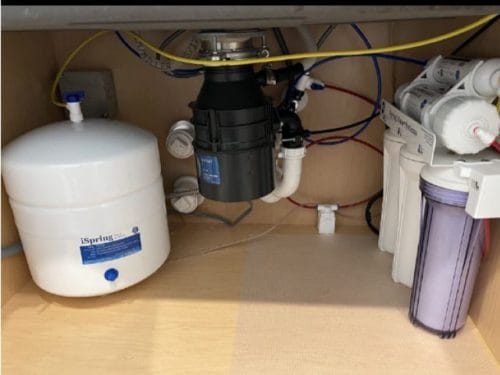
Pros
- All the components of the reverse osmosis system are high quality and the package comes with a bag of ‘spare parts as well
- Brings down TDS by a great deal as promised – even for well water
- Extremely responsive customer care that will resolve all your issues even after several years of purchase
Cons
- Prone to pinhole water leakages over time
- Some customers complain that the plastic bladder inside the tank deteriorates over time
To learn more, visit iSpring RCC7 review page.
Home Master TMHP – Best Reverse Osmosis System for Well Water
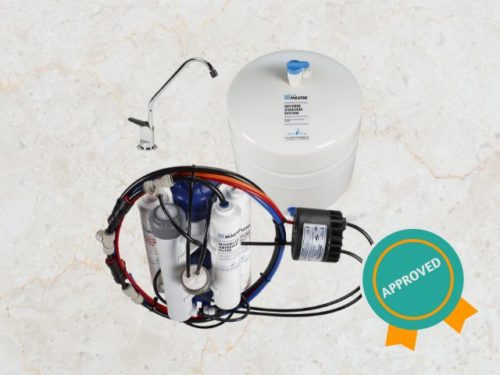
Features:
| Our Rating | 4.6 / 5 |
| Price | $$$$ |
| Flow Rate | 1 Gallon per Minute |
| Filter Process | 9 stages of Filtration (Modular Sediment filter, Iron Filter With catalytic carbon, Ultra Violet Sterilizer filter, RO Membrane, and a Remineralization filter) |
| Annual Cost | $140 – $153 |
| Warranty | 5 year limited warranty |
| Life Span | 1 year for the RO filter, 3 – 5 years for the RO membrane |
| Certification | Certified frustration-free / EPA Registered |
| Waste WaterRatio | 1:1 |
The flow rate of the Home Master TMHP Hydroperfection is about two times faster than most other reverse osmosis systems. Still, to combat the low-pressure problem that is often faced by well water homeowners, the water filtration system comes with a non-electric permeate pump which can increase the incoming water pressure.
An additional feature that it offers is the UV light sterilizer filter not offered in most filter systems. This will kill any virus, bacteria, and living microorganisms found in the well water sources. The light can even be seen as a soft blue glow at the top of the module.
The permeate pump included in its design also reduces TDS creep. Similar to the Home Master TMAFC, the Home Master TMHP Hydroperfection also remineralizes water with healthy minerals once when it flows into the storage tank and once before going into the faucet.
Pros
- Compared to most others, this water filtration system will make zero noise
- The system is reliable over many years of use and will provide you with great healthy water quality throughout, as the permeate pump decreases TDS creep
- Very responsive and professional customer service
Cons
- Cannot be installed without the help of a professional
- The design of the product is amatuer and not compact for an under-sink filter system
To learn more, visit Home Master TMHP review page.
APEC RO-PH90 – Best Under Sink Reverse Osmosis System
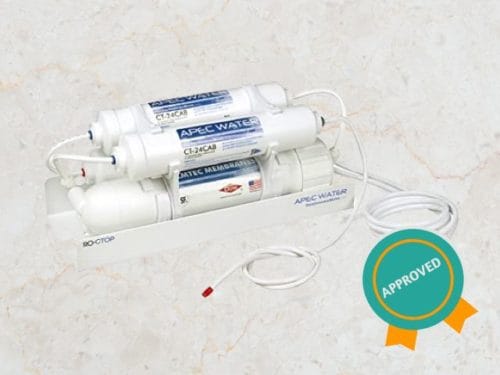
Features:
| Our Rating | 4.6 / 5 |
| Price | $$$ |
| Flow Rate | 0.25 Gallons per Minute |
| Filter Process | 6 stages of Filtration (5-micron Sediment filter, twin Premium Extruded Carbon Block filters, a high-graded FILMTEC RO membrane filters, an Advanced Coconut Shell Refining Carbon Post Filter, and a Calcite Acidic Water Neutralizer) |
| Annual Cost | $73 – $160 |
| Warranty | 1 year limited warranty / 2 years extended manufacturer warranty available upon registration |
| Life Span | 1 year for all the cartridges, 3 – 5 the RO membrane |
| Certification | Certified WQA water specialist |
| Waste WaterRatio | 1:3 |
APEC RO-PH90 comes with a 4 gallons capacity storage tank to produce drinking bottled water instantly from the faucet. This could be both an advantage or disadvantage for you depending on the space you have at your home. But if you’re not too worried about a big filter system and won’t be porting it a lot, then this is a great benefit.
Although for some people, such reverse osmosis systems are too bulky to be good under sink RO systems, a great advantage is that with the right additional equipment, it can easily be connected to your fridge as well.
It offers a neutralizer filter, which could also be called the alkaline remineralization filter, that eventually increases the pH of the water to 8-9 which claims to be optimum for the absorption of our body. This is actually the enhanced pH of water which makes it a little alkaline for those who may like it.
While most of the system has alkaline features in it, the APEC RO PH-90 is one of our recommended alkaline reverse osmosis water filters. Let’s take a deep dive into what is so great about this water filter.
Pros
- Can be easily and quickly installed with the help of the instructions manual and tutorial videos
- Saves you from TDS creep and lowers the levels by a great deal
- Low water pressure can easily be fixed by a higher-capacity tubing replacement
Cons
- Mostly results in a small number of air bubbles and the water isn’t as alkaline as many customers prefer
- Waste water ratio has been observed to be higher than claimed
To learn more, visit APEC RO-PH90 review page.
AquaTru – Modern Countertop RO System
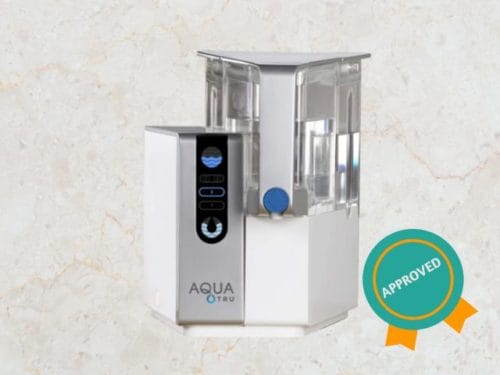
Features:
| Our Rating | 4.5 / 5 |
| Price | $$$$ |
| Flow Rate | 0.075 Gallons per Minute |
| Filter Process | 4 stages of Filtration (Pre-filtration system, granular activated carbon filter, Reverse Osmosis Filters, VOC Carbon Filter) |
| Annual Cost | $80 – $100 |
| Warranty | 1 year limited warranty |
| Life Span | 1 year for the pre-filters and the VOC carbon filter, 2 years for the reverse osmosis membrane |
| Certification | Certified by NSF/ANSI 42, 53, and 58 |
| Waste WaterRatio | 1.8:1 |
AquaTru comes forward with three main goals in all of its designs – portability, easy setup, and cost-efficient filtration and purification system to secure drinking pure water.
What makes it different from the rest of the reverse osmosis systems discussed here is that this tap water filtration system is not meant to go under the kitchen sink, rather it is one of the countertop reverse osmosis filters.
If you are worried that this might ruin your kitchen’s aesthetic, worry no more! It has a compact and sleek design. What’s more, is that it also allows you to access drinking pure water easily from its One-Touch Water Dispensing system.
The filtered water tank also has a full sensor, so when the tank is full, filtering stops. Similarly, when the water tank needs to be emptied of wastewater and refilled, there’s a large indicator on the front display.
This is our top recommendation for you if you hate the installation process of tap water filtration systems. The AquaTru has the easiest set-up so far, with zero tools and a total of 10 to 15 minutes required. As long as you follow the manual, you will have no trouble.
Pros
- Offers great-tasting water that is just as healthy
- Reduces TDS creep by a great extent
- Easy to use and stays functional as long as it’s not interrupted
Cons
- Components are prone to easy breakage over time and are not the best option if you have less counter space
- Some customers complain that it does not produce water for more than 2 to 3 people per day
To learn more, you can visit our AquaTru water filter review.
What Is Reverse Osmosis System?
The success of the reverse osmosis process hinges largely on whether or not the filter does its job. The filter, which is also often referred to as the semi-permeable membrane is responsible for separating the water from the impurities.
You’ll notice that the filter itself features plenty of small pores. This is necessary because the impurities need to be completely eliminated from the water. Larger pores would just allow those contaminants to pass through.
When we’re talking impurities, we’re referring to any foreign particles that could have been in the water previously. Even microscopic particles such as bacteria are blocked by the reverse osmosis water filter.
How to Pick the Best Reverse Osmosis Water Filter?
How can you make sure that you are getting the best RO system for your home? You can get on the right track by taking the following factors into consideration.
Water Source
Where your water comes from should be among your main considerations if you’re on the market for a reverse osmosis system.
Homeowners who get their water from private wells will want to invest more in their new system. More often than not, the water coming from a private well is loaded with all kinds of contaminants. Microorganisms are especially abundant in that kind of water.
A water filtration system equipped with some kind of UV light sterilizer is better suited for those who get their water from a private well.
If your water comes from a water treatment plant, a less sophisticated system should suffice.
Water Pressure
Some reverse osmosis systems come equipped with a permeate pump. Whether or not your system will need a permeate pump depends on what kind of water pressure you’re getting at home.
If the water pressure in your home falls below 40PSI, you will most likely need a system equipped with a permeate pump. Without enough pressure, the water may not be properly filtered, and you could end up drinking something contaminated.
Waste Water
Simply put, there is no way to completely eliminate wastewater from the equation if you are using an RO system. This is true even if you have the best reverse osmosis systems installed in your home.
All that said, you can still get a system that produces only a minimal amount of wastewater.
The so-called “zero waste” systems are ideal for minimizing wastewater production because they circulate the unclean water back into the system until it can be processed again. Look for those if you want to avoid having too much dirty water stuck inside your system.
Maintenance Cost
There are two things you need to keep in mind if you want to pinpoint the maintenance cost for your unit.
First, you have to check how much the replacement filters cost. Some replacement filters are available for as low as $25 while others may be sold at double that price point. Check out which replacement filters your system needs before deciding whether or not to purchase them.
The other consideration to keep in mind is the longevity of the filters. You will find filters that only last for about 2 years. As much as possible, try to find the units which utilize filters that can remain in service for about 4 years or something closer to that.
Remineralization Capabilities
Reverse osmosis systems are quite thorough. Because of that, they will also remove elements that you actually want in your water supply such as minerals.
Even though mineralized water can leave stains on clothes, you still need it because it provides important nutrients.
You can ensure that you still get a steady supply of minerals from your water by finding those systems that make use of a remineralization filter.
What Does Reverse Osmosis Water System Remove?
One of the reasons why reverse osmosis water filters stand out from other water filtration systems is that they excel at removing foreign bodies.
These systems will target the common contaminants that are found in the water such as salt and sediments that may enter the supply via erosion. It’s crucial for any home-based system to get rid of those contaminants simply because they tend to be so abundant.
Fluoride is yet another common contaminant that is removed by reverse osmosis systems. Elements such as arsenic and chlorine are also targeted.
Of course, those are not the most serious threats to your health that could come from the water supply. The good news is that the aforementioned filtration systems will also work on removing pesticides and volatile organic compounds (VOCs).
Bacteria and viruses that somehow sneak into the water supply can also be removed through the process of reverse osmosis.
As noted earlier, certain minerals that you don’t want to be taken out of the water may also be removed by RO filters.
How Do Reverse Osmosis Water Filters Work?
Filtration through reverse osmosis takes place over the course of different stages. The process also typically involves more than just one filter.
Step 1: Pre-filtration
To get things started, the water that enters the system, whether it’s an under sink reverse osmosis system or not, must first make it through pre-filtration. During this early stage, the focus is mainly on getting rid of the larger contaminants that may be floating around in the water.
Two different kinds of filters are often used during the pre-filtration process, with those being the carbon and sediment filters.
Pre-filtration is necessary because those larger contaminants could inflict serious damage upon the RO filter if they are not dealt with beforehand.
Step 2: The Reverse Osmosis Membrane
Now that the larger contaminants have been handled correctly, the process can continue to the next step. The next step in question involves the RO filter.
Pressure is again applied to the water in order to force it through the finer pores of the RO membrane. This time, the smaller contaminants will be targeted and promptly removed from the water.
Step 3: Storage
Your system should already have produced some filtered water after the first 2 stages. It’s now time for the system to store that water.
Reverse osmosis systems have storage tanks precisely for that reason. The system will continue to filter the water until the tank has been filled up.
Benefits And Drawbacks Of RO System
Unsurprisingly, there are benefits and drawbacks to using a reverse osmosis system. Here are the main points you need to know to determine if the system is right for you.
Benefits
The Water Produced Is Pretty Close to Pure Water
The water you get from a reverse osmosis system is the closest thing you’ll get to completely pure water. RO systems excel at cleaning up the water, and you can rely on them to get rid of the dissolved solids.
Refer back to the list of contaminants removed above to find out how comprehensive reverse osmosis systems are when it comes to cleaning.
Does Not Get in the Way
Adding a new water filtration system can seem like such a good idea at first. But then you realize how often it will be in your way and you start to second guess your decision to purchase one.
The great thing about many RO systems is that they can fit conveniently under your kitchen sink. You can continually use them without them ever being a hindrance to your work in the kitchen.
No Installation Issues
Compared to many other water filtration systems, the RO units are very easy to install. You should be able to get it done even if you don’t have a lot of experience working with household appliances.
Drawbacks
Minerals May Be Removed
The biggest drawback to using a reverse osmosis system is that you may be taking out important minerals from the water by using it. Given how often you drink water over the course of a day, it probably accounts for a huge chunk of your mineral intake.
Thankfully, you can remineralize your water to minimize the impact of this drawback.
Optional Add-Ons For Reverse Osmosis System
The reverse osmosis water filter does not only remove 99.99% of water contaminants and pathogens, but also the essential minerals in it. This is the main reason why the filtered water from a RO system is slightly acidic.
You might want to consider reverse osmosis systems that come with some add-on parts such as alkaline remineralization, UV lights, and permeate pumps.
- Alkaline Remineralization: RO water systems produce clean and slightly acidic water. A reverse osmosis water filter that comes with alkaline remineralization on the last filtration stage adds the essential alkaline minerals to your filtered
- Permeate Pump: Permeate pump is mainly for houses that are low in water pressure. Contaminated water will be pushed across to the other side of the reverse osmosis membrane leaving the contaminants behind. Hence, it needs a decent water pressure. Well water user is encouraged to have the permeate pump installed with the reverse osmosis system.
- UV Light: This is an added disinfection feature on your RO system that is responsible for killing viruses, E. Coli, cysts, algae, giardia, and other bacteria present in water, especially for well water sources.
What Is TDS?
TDS stands for total dissolved solids and this is natural for all raw water sources. It refers to all inorganic positive (cation) and negative (anion) ions dissolved in water. Some of the common inorganic salts soluble in water include potassium, sodium, magnesium, chloride, carbonates, bicarbonates, sulfates, and nitrates.
Using a TDS meter is the most practical and efficient way of measuring how many dissolved solids are present in the water. Modern RO systems have a built-in TDS meter so you can check on a real-time basis the quality of your filtered water. Otherwise, a separate handheld TDS meter can be used to measure the quality of the water.
TDS measure is expressed in mg/L or ppm. Based on EPA standards, potable water among households must have a maximum TDS level of 500 ppm. When your faucet water has a high TDS level, it isn’t suitable for drinking.
Reverse Osmosis System Installation
The first step of the installation process involves toggling the cold and hot water shut-offs inside your home. You specifically want them to be inactive during the installation process.
Next, take out the filter assembly and hang that on the wall of the sink base. You can now go ahead and install the saddle valve that was packaged together with your system.
Turn your attention to the color-coded water supply line next and cut it. After cutting, position it above the cabinet base and fasten the plastic tubing to the supply valve.
Connect the supply and waste lines to the fittings on the base of your faucet. Shorten them as appropriate, but don’t touch the black waste line.
Link the faucet to the sink and follow that by placing the drain line adapter under the sink basket. Cut off the waste line now and make sure it goes into the adapter.
Get the storage tank now and place that in its designated location before installing the waterline.
With all that done, you can now start using your reverse osmosis filtration system.
RO System Maintenance
Maintenance, as it pertains to RO systems, means managing the filters. The tricky part is that the filters used by most reverse osmosis systems feature different lifespans.
The filters that take effect before and after the RO filter has done its job are the ones that don’t last very long. You can expect them to remain in working condition for about a year, but you should really start to check on them once they hit the 6-month mark.
As for the reverse osmosis filter itself, you don’t need to worry about a replacement until after 2 years. Once you get to that point, pay closer attention to the condition of the reverse osmosis filters.
FAQs On Reverse Osmosis Systems
Why Should I Rely on a Reverse Osmosis System Instead of Using Bottled Water?
People like to drink bottled water because it’s convenient and they can be confident that they are consuming something clean. The main issue with relying so heavily on bottled water though is that you end up producing a lot of plastic waste. The world is already suffering due to how much plastic is in the environment and you should avoid contributing to that problem if possible.
Reverse osmosis systems give you the same quality of water without the accompanying plastic waste.
How Much Waste Water Is Produced by a Reverse Osmosis System?
There’s no getting around the fact that wastewater will be produced if you use an RO unit. You may even end up with about 4 gallons of wastewater for each gallon of clean water. That is obviously a problem.
To minimize that issue, look for RO systems that recycle the water they don’t clean up right away.
What Does Water Produced by a Reverse Osmosis System Taste Like?
Water produced via reverse osmosis does not taste bad per se, but it’s hard to say that it tastes great as well. The best way to describe the flavor is that it’s bland. The water tastes that way because so many of the foreign entities have been removed.
You will likely need some time to get used to the new taste of the water, but it’s not too bad.
Do I Need a Reverse Osmosis System with a UV Light?
You may find some RO systems that are bundled together with UV lights. Those UV lights are actually meaningful additions. They help clean the water further as they specifically target bacteria and viruses.
How Much Will I Have to Spend if I Want a Reverse Osmosis System in My Home?
Homeowners can still add an RO system to their homes even if they don’t have a limitless budget to draw from. Per HomeAdvisor, there are RO units available for as low as $150. If you have more money to spend, there are more feature-rich options sold for around $1,000.
Wrapping Up
Everyone has their own requirement when it comes to picking the best reverse osmosis systems. The above recommendation reflects our opinion and knowledge towards water treatment products.
It might be hard to decide which type of filtration system should you be taking. Don’t worry. Head to our recommended drinking water filter guides today and discover which water purifier suits your family’s needs.
In general, there are 11 types of drinking water purification systems. There must be one which is suitable for your home.
